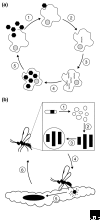New evolutionary frontiers from unusual virus genomes
- PMID: 15774035
- PMCID: PMC1088936
- DOI: 10.1186/gb-2005-6-3-212
New evolutionary frontiers from unusual virus genomes
Abstract
The sequences of two giant viral genomes, Mimivirus and a polydnavirus, have recently been published. Mimivirus has the largest known viral genome and encodes an unprecedented number of proteins, whereas the polydnavirus genome has an extremely low coding density and does not encode DNA-replication proteins. These and other unusual features challenge the way we view the evolution and definition of viruses.
Figures

Similar articles
-
Genomic and Proteomic Analyses Indicate that Banchine and Campoplegine Polydnaviruses Have Similar, if Not Identical, Viral Ancestors.J Virol. 2015 Sep;89(17):8909-21. doi: 10.1128/JVI.01001-15. Epub 2015 Jun 17. J Virol. 2015. PMID: 26085165 Free PMC article.
-
Polydnavirus genes and genomes: emerging gene families and new insights into polydnavirus replication.Annu Rev Entomol. 2004;49:431-56. doi: 10.1146/annurev.ento.49.072103.120132. Annu Rev Entomol. 2004. PMID: 14651471 Review.
-
The natural genetic engineering of polydnaviruses.Ann N Y Acad Sci. 2009 Oct;1178:146-56. doi: 10.1111/j.1749-6632.2009.05023.x. Ann N Y Acad Sci. 2009. PMID: 19845635
-
Polydnavirus-wasp associations: evolution, genome organization, and function.Curr Opin Virol. 2013 Oct;3(5):587-94. doi: 10.1016/j.coviro.2013.06.004. Epub 2013 Jun 29. Curr Opin Virol. 2013. PMID: 23816391 Review.
-
Evolutionary genomics of nucleo-cytoplasmic large DNA viruses.Virus Res. 2006 Apr;117(1):156-84. doi: 10.1016/j.virusres.2006.01.009. Epub 2006 Feb 21. Virus Res. 2006. PMID: 16494962 Review.
Cited by
-
Mimiviridae: An Expanding Family of Highly Diverse Large dsDNA Viruses Infecting a Wide Phylogenetic Range of Aquatic Eukaryotes.Viruses. 2018 Sep 18;10(9):506. doi: 10.3390/v10090506. Viruses. 2018. PMID: 30231528 Free PMC article. Review.
-
The Apis mellifera Filamentous Virus Genome.Viruses. 2015 Jul 9;7(7):3798-815. doi: 10.3390/v7072798. Viruses. 2015. PMID: 26184284 Free PMC article.
-
Gene and genome duplication in Acanthamoeba polyphaga Mimivirus.J Virol. 2005 Nov;79(22):14095-101. doi: 10.1128/JVI.79.22.14095-14101.2005. J Virol. 2005. PMID: 16254344 Free PMC article.
-
Curation of viral genomes: challenges, applications and the way forward.BMC Bioinformatics. 2006 Dec 18;7 Suppl 5(Suppl 5):S12. doi: 10.1186/1471-2105-7-S5-S12. BMC Bioinformatics. 2006. PMID: 17254296 Free PMC article.
-
Reared microgastrine wasps (Hymenoptera: Braconidae) from Yanayacu Biological Station and environs (Napo Province, Ecuador): diversity and host specialization.J Insect Sci. 2009;9:31. doi: 10.1673/031.009.3101. J Insect Sci. 2009. PMID: 19613864 Free PMC article.
References
-
- Bergh O, Borsheim KK, Bratbak G, Heldal M. High abundance of viruses found in aquatic environments. Nature. 1989;340:467–468. - PubMed
-
- Filée J, Forterre P, Laurent J. The role played by viruses in the evolution of their hosts: a view based on informational protein phylogenies. Res Microbiol. 2003;154:237–243. - PubMed
-
- Mindell DP, Villarreal L. Don't forget about viruses. Science. 2003;302:1677. - PubMed
-
- Raoult D, Audic S, Robert C, Abergel C, Renesto P, Ogata H, La Scola B, Suzan M, Claverie J-M. The 1.2-megabase genome sequence of Mimivirus. Science. 2004;306:1344–1350. - PubMed
-
- Espagne E, Dupuy C, Huguet E, Cattolico L, Provost B, Martins N, Poirie M, Periquet G, Drezen JM. Genome sequence of a polydnavirus: insights into symbiotic viral evolution. Science. 2004;306:286–289. - PubMed

